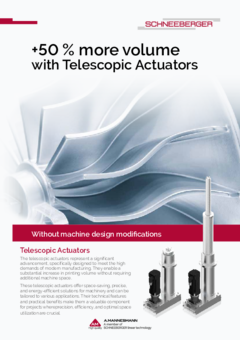Precise linear movements with actuators from A.MANNESMANN

The linear actuator is a functional module for converting the drive rotation into a translational movement. It includes the expansion of a ball screw by its bearings, with a solid longitudinal guide and a dynamic drive system. The linear actuator can be usefully supplemented by integrated force transducers, path measurement systems and monitoring elements.
The linear actuator in the precision design from A.MANNESMANN is a highly-accurate functional control unit that can be used to realize challenging drive and positioning tasks with the utmost infeed accuracy in a jerk-free operation. These tasks include displacement movements of components with complex, path-dependent processes as well as pressing and joining tasks with direct force-path evaluation.
1-stage linear actuators are increasingly replacing traditionally used hydraulic drives, in plastic machines for example. Depending on the task and its framework conditions, a wide variety of designs are required that can be used to achieve a higher level of precision, a shorter cycle time and lower energy consumption.
2-stage telescope actuators are used in a variety of ways in mechanical and plant engineering where more space is required, such as in aerospace, special machine construction or process engineering.
The patented 4-stage telescope actuators are used in confined spaces due to their highly compact design. The high-precision positioning with telescope actuators occurs in machines with innovative technologies, such as additive manufacturing.


The telescope actuator is a ready-to-install machine assembly that is used to convert the driven rotational movement of a motor into a translatory linear movement. The telescopic multi-stage ability of the ball screw spindles makes it possible for the actuator to achieve a very large extension with the shortest-possible retracted block length. Complex machine movements can be numerically controlled and safely monitored with this very compact unit.
Due to the little space it requires, the custom design telescope actuator from A.MANNESMANN is particularly well-suited for installation in very confined installation spaces. It is designed for high-precision, jerk-free positioning and movement operation in horizontal or vertical installation positions. The load bearing capacity can occur here one-way or two-way. The preloaded ball screw nuts guarantee freedom from backlash, even with very high tensile and compressive loads.
The AM telescope actuator can be designed as an individual or dual system. With a dual system, both parallel-arranged actuator systems are driven by a joint motor so that they extend and retract synchronously.
The technical basis of the telescope actuators is the ball screw from A.MANNESMANN, which has been tried and proven in machine tool building. That is why the high performance capacity and the long system durability are a matter of course with these actuators. The high load bearing capacity, the high positioning accuracy, the high dynamics (also at a low travel speed) and the long usage duration are important arguments for using A.MANNESMANN telescope actuators in addition to the compact design.
Our telescope actuator largely determines the performance and accuracy of modern machines. However, this high technical standard can only be met if it is used properly and correctly. It is only intended for industrial use in a complete machine. Other uses require express approval from A.MANNESMANN MASCHINENFABRIK GmbH.

Precision ball screws require the perfect interplay between nuts, balls and ballscrew shaft. The individual parts ground in very tight tolerances are brought to the highest level of precision through the manual assembly by highly skilled specialists.
Only the highest quality materials are used to produce the components. The wear-resistant, long-term nitrided surfaces of all of the ballscrews as well as the through-hardened nuts and balls, optimal ball recirculation systems and effective wipers guarantee the high load capacity and precision over a very long useful life.
The high geometrical accuracies and the preload of the double nuts in 2-point contact during assembly are the basis for the high nut rigidity with simultaneously very low inner friction. This is also reflected in the very high system efficiency and in the low idling and breakaway torques.
The even torque curve, the high level of smooth running and the lowest possible vibration tendency over the entire thread length minimize the power loss and therefore also the heat development, regardless of whether the ball screw is lubricated with oil or with grease.
The installation and load direction of precision ball screws is generally arbitrary and does not affect its functionality.
The designs and the connection dimensions of the precision ball screws are conform with DIN ISO 3408 or DIN 69051 or correspond to individual customer requirements as special designs.



